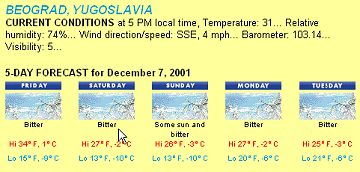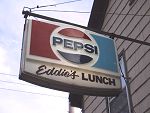The first season of the CBS television program The Amazing Race ends tonight with the grand finale.
Since the program started, we have been Big Fans. Although, as Edward Hasbrouck points out in an interesting series of columns, the travel in the program is a distant relative of “real” life on the road (and how could it be, with TV cameras on all the time, and a time limit?), I find the show appeals to my latent desire to move. It’s like the Reader’s Digest of travel, and sometimes Reader’s Digesting something can be useful (and even entertaining).
Like the rest of North America we were biggest fans of Kevin and Drew, the rollicking New Yorkers who were eliminated two weeks ago. Now that it’s down to the finish with three teams, I’m torn between the Rob/Brennan team and the Frank/Margarita team. I am not torn, however, by the quite pleasure I take at the demise of the Joe/Bill team (aka “Team Guido” after their dog); they have been consistently snotty, and deserve to lose (of course by some miracle, they could still win, even though they’re a full 24 hours behind the others at this point).
Catherine and I agree that of all the “reality TV” shows, The Amazing Race is the only one we’d relish participating in. Unfortunately it looks they’ve already cast the next episode. I suppose there’s always next time. Still unclear as to whether having wee Oliver strapped to our back would slow us down.
Be sure to watch CBS tonight, 10 p.m. Atlantic Time, for the thrilling conclusion.
Sixteen years ago I made my first Usenet posting (I can find this now because Google now indexes Usenet back to 1981).
Appropriately enough, my posting, which was to the ut.general newsgroup (the general newsgroup at the University of Toronto) was a question about the ‘net itself (this was all before the Internet was called such):
Anyone who may be able to offer a concise explantion of the differences, and similarities (as well as cross-overs) between UseNet, BITNET, NetNorth, ARPANET and any other –NET please do so… It’s got me totally confused !
There were no replies. I must have figured out the answer on my own.
The email address I used with the post — traill@utcsri.UUCP — is a good indicator of the era. At the time I was a volunteer with the Athenians Project at U of T, and this afforded me, somewhat unofficially, access to the whatevernet.
Interestingly enough, after that first posting, and a couple of others that summer, my next posting wasn’t until 7 years later, in November of 1992. This posting was to the venerable comp.dcom.telecom newsgroup, at that time moderated by the venerable Patrick Townson.
Pat’s life over the past few years appears to have been a constant set of challenges; you can pull together the pieces from the comp.dcom.telecom archives, or read a recent summary from Pat here.
I’ve just returned from a short vacation to Boston. I was away entirely from email for 4 days — probably the longest gap in 10 years. While I was away, I received 461 new email messages. Of those, 10 were useful and important work, friend, or family-related email, about 30 were automatic system monitoring emails generating by various servers, and just over 400 were spam (the usual selection of “we can make part X of your body [small \| bigger]” and “you can make lots of money doing activity Y”).
This is now beyind annoying: it’s costing me too much time and money. What are my options?
Today’s 5-day weather forecast (courtesy The Old Farmer’s Almanac) for Belgrade, Yugoslavia:
![]()

![]()
It appears everyone will be in a bad mood until Sunday, when things will briefly pick up. On Monday, though, it’s back to full-on bitterness. Stay well, Balkan brothers and sisters.
 I’ve written here and here about Eddie’s Lunch, our neighbourhood grill.
I’ve written here and here about Eddie’s Lunch, our neighbourhood grill.
If you have read The Tipping Point by Malcolm Gladwell, which talks about social epidemics, you will know what I mean when I say that Eddie’s has tipped.
Eddie’s has always been a relatively successful local lunch counter; a renovation this spring (and into summer, alas!), has given them about triple the capacity. And they have, I think, been able to preserve a lot of the “Eddie’s ambience” in the updated space.
Now it used to be that the only people you ever heard of going to Eddie’s were people from the neighbourhood like photographer Jack LeClair (just up King St.) and poet Catherine Matthews (just across Prince St.).
But in the past two weeks there’s been a dramatic change: other people are starting to go to Eddie’s. Last week, for example, Roy Johnstone called me up to invite me to lunch; “how about Eddie’s?” said Roy. So a date was set. Then, just before heading out the door to Eddie’s, I got a call from Perry Williams wondering if I’d like to go to lunch at Eddie’s to discuss an idea bubbling through his head.
Today while stopping at Eddie’s for lunch myself, who should I see but local media mogul Kevin O’Brien leaving the restaurant with the selfsame Roy Johnstone.
And Bunbury consultant Rob Paterson has been spotted several times in Eddie’s enjoying their hearty breakfast.
Eddie’s has tipped. The world will never be the same.
At the Bangkok Hospital you can buy a vaginal delivery for $643. For an additional $80, you can have a painless vaginal delivery (painless!). You can get your tonsils out for $467.
One of the negative side-effects of having health care built in to our tax system is that we seldom have any idea what medical care costs.
I think it would be of tremendous benefit to give everyone a “receipt” every time they receive healthcare services. We wouldn’t change anything else — everything would still be covered as it is now — but we’d all know a lot more about what things cost. And perhaps both have more patience about tax increases, and more compassion for the health care systems challenges.
By the way, if you know someone staying in the Bangkok Hospital, you can send them a lovely card over the Internet, with messages including “Congratutations for your new family member” and “For a special person, with best health.”
If we ever needed evidence to support our suspicion that Canada is simply a creation of the CBC, consult clause 5.1 of the proposed agreement between the CBC and the Communication, Energy and Paperworkers Union of Canada: there is a job classification there called Virtual Reality Operator.
Presumably these are the CBC technicians who, among other things, make the sun come up, start the traffic up on the 401, make Knowlton Nash speak, put the Cheerios in the virtual grocery stores, etc. Lord knows what happens if they go on strike tomorrow afternoon.
Rally on, union brothers and sisters.
I have become a diehard fan of Grassy Hill Radio. I have never found a collection of music that so closely matches my own tastes. Every so often I’ll hear a song coming out of the iBook that particularly catches my attention and I’ll look over and see that it’s Ani Difranco singing. You can listen here for yourself.

 I am
I am